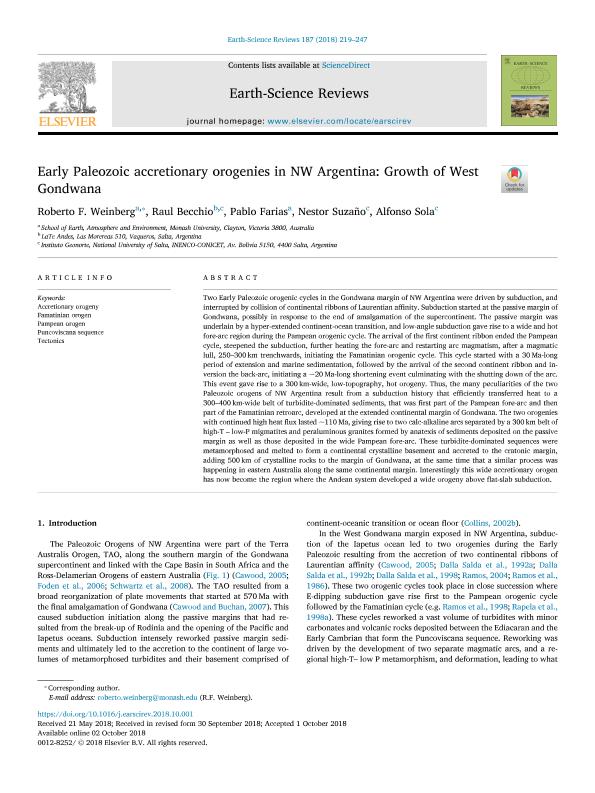Artículo
Early Paleozoic accretionary orogenies in NW Argentina: Growth of West Gondwana
Weinberg, Roberto F.; Becchio, Raul Alberto ; Farias, Pablo; Suzaño, Nestor Omar
; Farias, Pablo; Suzaño, Nestor Omar ; Sola, Alfonso Manuel
; Sola, Alfonso Manuel
 ; Farias, Pablo; Suzaño, Nestor Omar
; Farias, Pablo; Suzaño, Nestor Omar ; Sola, Alfonso Manuel
; Sola, Alfonso Manuel
Fecha de publicación:
12/2018
Editorial:
Elsevier Science
Revista:
Earth-science Reviews
ISSN:
0012-8252
Idioma:
Inglés
Tipo de recurso:
Artículo publicado
Clasificación temática:
Resumen
Two Early Paleozoic orogenic cycles in the Gondwana margin of NW Argentina were driven by subduction, and interrupted by collision of continental ribbons of Laurentian affinity. Subduction started at the passive margin of Gondwana, possibly in response to the end of amalgamation of the supercontinent. The passive margin was underlain by a hyper-extended continent-ocean transition, and low-angle subduction gave rise to a wide and hot fore-arc region during the Pampean orogenic cycle. The arrival of the first continent ribbon ended the Pampean cycle, steepened the subduction, further heating the fore-arc and restarting arc magmatism, after a magmatic lull, 250–300 km trenchwards, initiating the Famatinian orogenic cycle. This cycle started with a 30 Ma-long period of extension and marine sedimentation, followed by the arrival of the second continent ribbon and inversion the back-arc, initiating a ~20 Ma-long shortening event culminating with the shutting down of the arc. This event gave rise to a 300 km-wide, low-topography, hot orogeny. Thus, the many peculiarities of the two Paleozoic orogens of NW Argentina result from a subduction history that efficiently transferred heat to a 300–400 km-wide belt of turbidite-dominated sediments, that was first part of the Pampean fore-arc and then part of the Famatinian retroarc, developed at the extended continental margin of Gondwana. The two orogenies with continued high heat flux lasted ~110 Ma, giving rise to two calc-alkaline arcs separated by a 300 km belt of high-T – low-P migmatites and peraluminous granites formed by anatexis of sediments deposited on the passive margin as well as those deposited in the wide Pampean fore-arc. These turbidite-dominated sequences were metamorphosed and melted to form a continental crystalline basement and accreted to the cratonic margin, adding 500 km of crystalline rocks to the margin of Gondwana, at the same time that a similar process was happening in eastern Australia along the same continental margin. Interestingly this wide accretionary orogen has now become the region where the Andean system developed a wide orogeny above flat-slab subduction.
Archivos asociados
Licencia
Identificadores
Colecciones
Articulos(INENCO)
Articulos de INST.DE INVEST.EN ENERGIA NO CONVENCIONAL
Articulos de INST.DE INVEST.EN ENERGIA NO CONVENCIONAL
Citación
Weinberg, Roberto F.; Becchio, Raul Alberto; Farias, Pablo; Suzaño, Nestor Omar; Sola, Alfonso Manuel; Early Paleozoic accretionary orogenies in NW Argentina: Growth of West Gondwana; Elsevier Science; Earth-science Reviews; 187; 12-2018; 219-247
Compartir
Altmétricas



